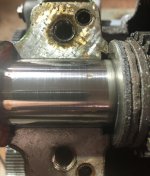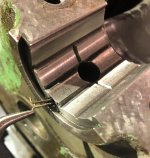Model 113A
Thank you everyone for your inputs.
The chuck is a little looser from just moving it by hand.
I have order a rebuild kit and manual and proper oil as suggested.
My current thinking is to flush and evaluate and reload with new oil
I should be able to see if the oil is winking in most cases.
I have a machine built pre war so it may have the cast iron bearings in the spindle.
How difficult is it to take apart the spindle and replace or adjust the shims.
I've done fussy work before in aligning a headstock but I don't want to open up a can of worms if I don't need to.
After perusing the manual it looks like a long haul to disassemble every piece.
I guess I'll have to go a step at a time and see.
other questions:
The tail stock has a live center that is stuck.
Any ideas on how to get it out without damage?
I have backed off the handle but it still won't budge.
I was thinking of apply a little heat to it?
Any other ideas?
The movers bumped the carriage handle and broke it.
I have removed it but need to replace the taped pin.
Where can I find more pins?
The cross find and compound rest seem to have worn lead screws.
Are parts (lead screw and nut) still available at reasonable cost?
So does this sound like a reasonable way forward?
Thoughts?
Rob
I think tobnpr may be right. I missed that had sat for 20 years. If it was oiled when it was parked that oil can turn hard. You can try a flush but I would oil all you can directly to the moving parts.
Think of how nice it would be to have the oiling system all fresh and clean. It will also help get you familiar with the working parts and possibly find and fix a problem before it destroys a shaft or bushing.
I see more damage from lack of oil than from normal wear In some cases that's why these old machines get pushed in the corner. There a few machines that were well taken care of when in use.
Just think of all the grit that old oil attracted in 20 years of sitting. Just waiting to score nice metal.
I wouldn't take anything apart accept what's needed
Your probably a good judge of what you have and what's needed. Your aware of the issue. I'm sure you will take care of your lathe.
If the spindle is stiff I wouldn't try to run it to loosen it up by running it. Its dry or has hardened swarf. You could do damage The bushing is wide and will get hot quickly.


 mllud:
mllud: 

